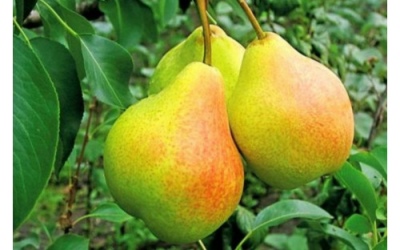
- Authors: Petrov Yu.A., Efimova N.V., Girichev V.S. (FGBNU Federal Research Center of Horticulture)
- Appeared when crossing: Elegant Efimova from free pollination
- Name synonyms: Pirus Banana
- Year of approval: 2008
- Fruit weight, g: 135±15
- Ripening terms: summer
- Fruit picking time: until mid-October
- Appointment: dining room
- Growth type: medium height, natural semi-dwarf
- Yield: high
Many gardeners enjoy growing pears. But most of them strive, which is quite reasonable, to periodically update their collection of varieties. And the Banana variety is good for this purpose - if you think about its cultivation correctly.
Breeding history
The culture was created in the All-Russian Scientific Center for Horticulture. The work on the project was carried out by breeders Petrov, Girichev and Efimova. The varietal material of pear Nadyadnaya Efimova was taken as a basis. It was improved by free crossing. In Russia, such a tree was allowed to grow in 2008.
Description of the variety
Banana pear, also known as Pirus Banana, has a table purpose. This is by nature a semi-dwarf tree, reaching a height of no more than 5 m. Its drooping crown is distinguished by a loose structure. Curved bare shoots are brown by default. The number of leaves is moderately large, and they themselves are oblong and smooth.
Fruit characteristics
The main features of the Banana pear are as follows:
weight from 120 to 150 grams;
the shape of the classic regular pear;
greenish, mixed with red blush, color;
smooth skin;
elongated and curved peduncle;
guaranteed keeping quality from 60 to 75 days.
Taste qualities
The creamy flesh of the Banana Pear has a fresh, sweet taste. She is given a tasting score of 4.6 out of five. Fresh fruits are crispy and juicy. With further storage, the juiciness remains in full. But the crunch is lost, giving way to the characteristic oiliness.
Ripening and fruiting
This pear belongs to the summer category. The first fruits appear in the 3-4th year of development. The harvest gathers the necessary consumer ripeness around 10 August. Further, the collection of new fruits is possible until mid-October. Normally, the tree bears harvests every year, without interruption.

Yield
The official description states fertility at 25 to 30 tonnes per hectare. The final result largely depends on the agricultural technique. But it is also impractical to discount weather conditions.
Growing regions
The plant is zoned in Central Russia. With care, you can try to cultivate it in areas with a more favorable climate. Growing in areas with the worst average annual conditions is impractical.
Self-fertility and the need for pollinators
The Banana variety pollinates itself only to a limited extent. It is difficult to do without helper plants. The best candidates are Severin and Permyachka pear varieties.
Landing
The distance between Banana Pear and other plants is the same as for other trees of this species. This culture is sun-loving, and it is a very bad idea to plant it in the shade. It is very important that the selected place is folded:
loam;
sod-podzolic soil;
chernozem.


Growing and care
Taking care of the Banana Pear is no different from taking care of other summer varieties. It is very important to choose areas with neutral or slightly acidic soil. And also it is necessary to check whether the chosen place is well drained. Additionally, before planting, it is worth saturating the soil:
superphosphate;
potassium salt;
wood ash.
Water the pear regularly. The most intensive irrigation should be in June and July, when the fruits are laid. Sanitary pruning is also recommended for her. The combination of phosphorus and organic matter is then applied to the soil every 3-5 years. In this case, it will be necessary to be guided by the peculiarities of the development of the trees themselves, their needs.




Like any other fruit trees, the pear needs protection from various diseases and pests. When planting a pear on your site, you need to know in advance what diseases you should beware of. To successfully carry out the struggle, it is necessary first to correctly identify the cause of the problem. It is important to distinguish signs of disease from manifestations of the presence of insects, mites, caterpillars and other types of pests.





































































